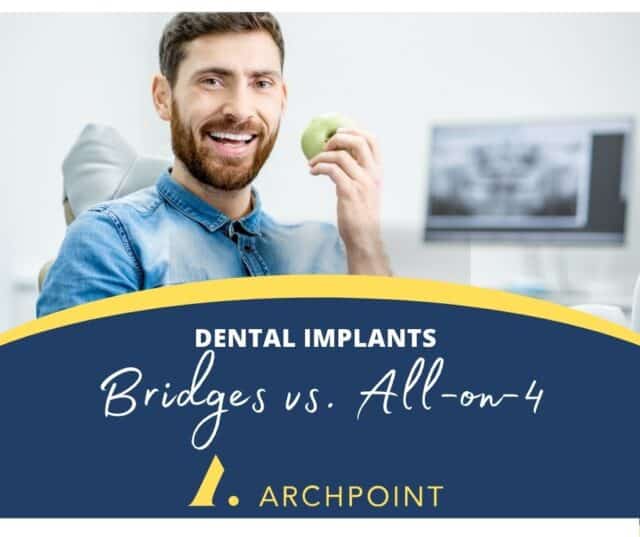Are you planning to replace or upgrade your smile from an old set of dentures? Or maybe you have several teeth that need to be removed and you simply feel like you’re “starting over” when it comes to having healthy teeth? All-on-4 or implant bridges are an excellent choice.
Compared to partials, full dentures, and fixed bridges, dental implants are far superior when it comes to permanent tooth replacement. They mimic natural teeth and have the ability to support longer, multi-tooth restorations like All-on-4 or implant bridges. Understanding the difference in these two different options will help you feel more prepared before your implant consultation.
What is an Implant Bridge?
An implant bridge is almost like a traditional dental bridge, except it’s supported by a pair of implants instead of natural teeth. This design makes it possible to fill in more missing teeth at one time, since conventional bridges can really only fill in 1-2 teeth at most.
With implant bridges, we’re using one implant at each end of the restoration, placing them on either side of the open area in your bite. So, it’s replacing all of the teeth between your implants as well as the ones where the implants are installed. Usually, implant bridges fill in anywhere from 3-4 teeth in a row. Occasionally we might even recommend using additional dental implants for the same prosthesis if we need it to be any longer.
What is All-on-4?
You could think of an All-on-4 (or All-on-6) implant system as being a full-arch dental bridge. Technically it’s not a bridge, because it’s filling in the space of both your teeth and the gum tissue immediately adjacent to them. But unlike a denture, it only follows the natural U-shaped curve of your jaw. All-on-4 implants are like a hybrid between fixed bridges and a full denture, replacing all of the teeth in your upper or lower jaw with one prosthesis.
As the name suggests, your full arch restoration is attached onto 4 or 6 dental implants. While this might not seem like enough implants for a full upper or lower set of teeth, it’s important to remember that implants are stronger than natural teeth. That’s why they’re able to support the weight of a full arch prosthesis, as long as they’re positioned at particular points in your jaw.
Is There Such a Thing as a Full Arch Implant Bridge?
When most people ask about a full arch implant bridge, they’re usually talking about an All-on-4 or All-on-6 treatment. Bridges technically only restore the “crown” or visible tooth portion of your smile. You would want one when there’s plenty of healthy gum tissue there. But extensive tooth loss usually triggers changes in the shape of your jaw, and your gums right along with it. So, with an All-on-4, we take your full arch bridge and also build out the gummy “ridge” that usually hugs the necks of your natural teeth. Essentially, we’re rebuilding both the tooth and the gums around it, so your prosthesis has both white and pink areas, filling in more than just tooth anatomy. This structural change is the key difference between a bridge and other tooth replacements.
When to Choose Implant Bridges Over Individual Implants
Let’s say for a moment that you’re not missing all of your teeth. Maybe you have a few here and there that are perfectly healthy and stable enough for several more years of use. When that’s the case, we don’t want to extract them simply to install a long, full-arch prosthesis. In those scenarios, the best solution is to just place individual implants between the teeth, or an implant supported bridge.
Typically, we don’t need to replace multiple teeth in a row with their own individual implant. Since implants are strong enough to support more weight than an anatomical tooth, it’s less invasive to use a pair of implants for a fixed bridge. For example, if you have three missing teeth it would probably be best to get two implants with a three-unit dental bridge. But if you only have two teeth missing, you will go with an individual implant and crown for each one of them.
When to Choose All-on-4 Implants
Once we’re to the point of restoring a full upper or lower set of teeth, we really only need 4-6 dental implants per arch. When you omit wisdom teeth (third molars) that’s 14 teeth per arch. Depending on your bone anatomy and how much support there is, we would choose specific points in your jaw to install your dental implants. For people with a bit more bone loss, six implants are usually best. That’s a little less than a 1:2 ratio of dental implants to missing teeth. Each implant is basically supporting the weight of just over two teeth, which is extremely safe and predictable.
Which One is Right for Me?
Anyone who has experienced tooth loss knows how embarrassing and debilitating it can feel to not have a healthy, functional smile. Usually, our implant specialists want to do everything we can to help you maintain the natural teeth you have, then replace the missing ones around them. But if that’s not in the best interest of your overall health, therapeutic tooth removal is also an option.
Whenever you visit our DFW implant office, we’ll walk you through our findings and discuss what your goals are. We’re here to be your partner in oral health and will only recommend the same type of treatment that we would want for our own smiles or those of our family members.
Dental Implants in DFW
ARCHPOINT Implant Dentistry offers a wide variety of tooth replacement options, including both implant bridges and All-on-4 implant designs. Those are just two examples of several you have to choose from.
No matter how many teeth you have missing or what your smile goals are, dental implants are one of the absolute best options when it comes to restoring your smile. Contact ARCHPOINT in Dallas or Ft. Worth to learn more about how our DFW implant specialist can help you enjoy the smile you deserve.








